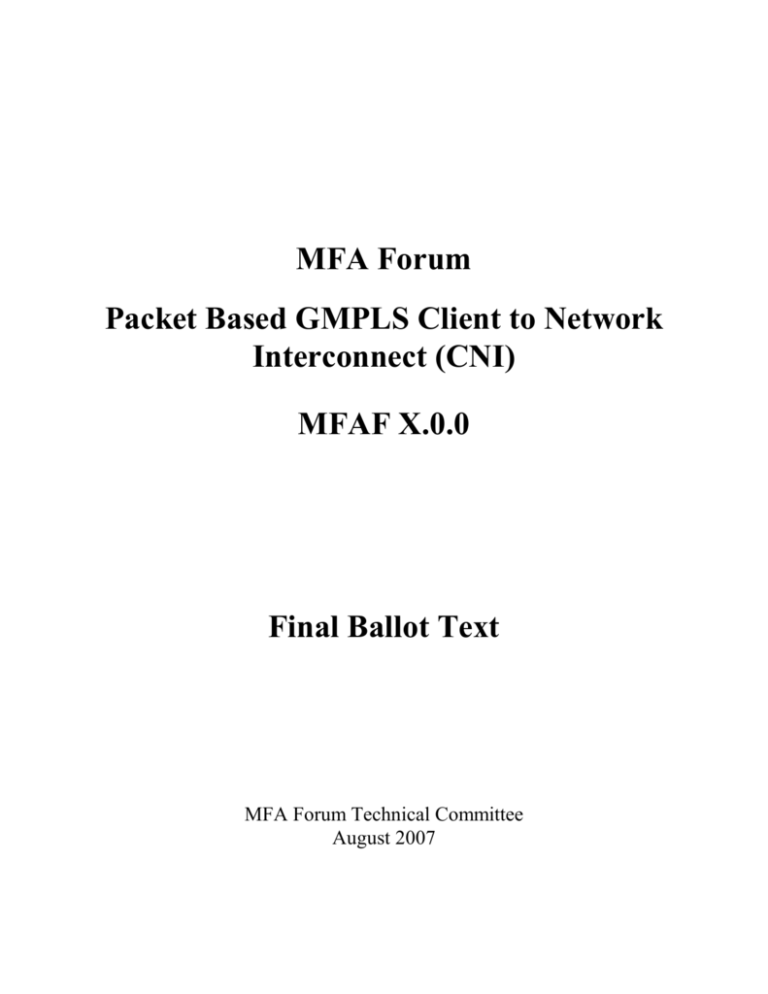
MFA Forum
Packet Based GMPLS Client to Network
Interconnect (CNI)
MFAF X.0.0
Final Ballot Text
MFA Forum Technical Committee
August 2007
Packet Based GMPLS CNI
MPLS2007.032.03
Note: The user’s attention is called to the possibility that implementation of the MFA Forum implementation
agreement contained herein may require the use of inventions covered by patent rights held by third parties. By
publication of this MFA Forum implementation agreement the MFA Forum makes no representation that the
implementation of the specification will not infringe on any third party rights. The MFA Forum take no position with
respect to any claim that has been or may be asserted by any third party, the validity of any patent rights related to
any such claims, or the extent to which a license to use any such rights may not be available.
In most team endeavors, the efforts of several individuals deserve special recognition. This specification is no
exception. The MFA Forum gratefully thanks the following individuals and respective employers for their
contributions to this document.
Rao Cherukuri (Editor)
David A. Sinicrope (Editor)
Juniper Networks
Ericsson
Santosh Kolenchery
John Kenney
Ina Minei
Ericsson
Tellabs
Juniper Networks
For more information contact:
The MFA Forum
Suite 307
39355 California Street
Fremont, CA 94538 USA
Phone: +1 (510) 608-3997
FAX:
+1 (510) 608-5917
E-Mail: info@mfaforum.org
WWW: http://www.mfaforum.org/
Full Notice
Copyright © 2007 MFA Forum.
All rights reserved.
This document and translations of it may be copied and furnished to others, and works that comment on
or otherwise explain it or assist in its implementation may be prepared, copied, published and
distributed, in whole or in part, without restriction of any kind, provided that the above copyright notice
and this paragraph are included on all such copies and derivative works. However, this document itself
may not be modified in any way, such as by removing the copyright notice or references to the MFA
Forum, except as needed for the purpose of developing MPLS implementation agreements (in which case
the procedures copyrights defined by the MFA Forum must be followed), or as required to translate it
into languages other than English
This document and the information contained herein is provided on an "AS IS" basis and THE MFA
FORUM DISCLAIMS ALL WARRANTIES, EXPRESS OR IMPLIED, INCLUDING BUT NOT LIMITED
TO ANY WARRANTY THAT THE USE OF THE INFORMATION HEREIN WILL NOT INFRINGE ANY
RIGHTS OR ANY IMPLIED WARRANTIES OF MERCHANTABILITY OR FITNESS FOR A
PARTICULAR PURPOSE.
Page ii
August 2007
Packet Based GMPLS CNI
MPLS2007.032.03
Table of Contents
1
INTRODUCTION ............................................................................................................................................... 5
1.1
1.2
1.3
1.4
2
PURPOSE ............................................................................................................................................................ 5
OVERVIEW ......................................................................................................................................................... 5
SCOPE ................................................................................................................................................................ 6
REQUIREMENTS ................................................................................................................................................. 6
DEFINITIONS ..................................................................................................................................................... 7
2.1
ACRONYMS ........................................................................................................................................................ 7
3
NORMATIVE REFERENCES .......................................................................................................................... 8
4
REFERENCE ARCHITECTURE ..................................................................................................................... 9
5
SUPPORTED LAYER 2 ENCAPSULATIONS OF MPLS PACKETS........................................................ 10
6
USER PLANE .................................................................................................................................................... 10
7
SIGNALING AND CONTROL ........................................................................................................................ 11
7.1
7.2
7.3
7.4
7.4.1
8
OAM ................................................................................................................................................................... 13
8.1
8.2
9
ACCESS LINK INTEGRITY .................................................................................................................................. 13
LSP OAM........................................................................................................................................................ 13
SWITCHED LSP SIGNALING........................................................................................................................ 13
9.1
9.1.1
9.1.2
9.2
9.3
9.4
9.5
9.5.1
9.5.2
9.5.3
9.5.4
A
MPLS CLIENT-NETWORK SIGNALING .............................................................................................................. 11
GMPLS SIGNALING CHANNEL ......................................................................................................................... 11
ROUTING AND ADDRESSING ............................................................................................................................. 11
QOS AND TRAFFIC ENGINEERING ..................................................................................................................... 12
Multi-class LSPs ............................................................................................................................................. 12
EXPLICIT ROUTING OBJECT (ERO) .................................................................................................................. 14
ERO Sender Processing .................................................................................................................................. 14
ERO Receive Processing ................................................................................................................................. 14
RECORD ROUTING OBJECT (RRO) ................................................................................................................... 14
NOTIFICATION .................................................................................................................................................. 15
CONNECTION DELETION WITH PATHERR ......................................................................................................... 15
SIGNALING EXTENSIONS FOR MULTI-CLASS LSPS ............................................................................................ 15
Setup and holding preemption priorities ......................................................................................................... 15
Extended Classtype object .............................................................................................................................. 15
RSVP signaling extension ............................................................................................................................... 16
RSVP error processing .................................................................................................................................... 17
APPENDIX A – ALTERNATE OAM MECHANISMS FOR THE CNI ...................................................... 18
(INFORMATIVE) ..................................................................................................................................................... 18
A.1
A.2
ACCESS LINK INTEGRITY .................................................................................................................................. 18
LSP OAM........................................................................................................................................................ 18
August 2007
Page iii
Packet Based GMPLS CNI
MPLS2007.032.03
Revision History
Version
MFAF X.0.0
Page iv
Change
Initial version
August 2007
Date
Packet Based GMPLS CNI
1
MPLS2007.032.03
Introduction
1.1 Purpose
The purpose of this specification is to define a GMPLS-based Client to Network Interconnect (CNI)
for establishing GMPLS Traffic Engineered (TE) Label Switched Paths (LSPs). The CNI provides
an interface to an IP-MPLS Network for interconnection of client equipment. The client equipment
can be Customer Premise Equipment (CPE) or other network elements in an IP-MPLS network. The
CNI supports switched TE-LSPs. Provisioned LSPs are for further study.
1.2 Overview
Many services such as LAN inter-connect, audio and video streaming, VoIP telephony and
multimedia conferencing use protocols that require quality of service in the network. The purpose of
the CNI is to provide a means to create and manage a TE-LSP overlay network. This overlay network
interconnects client equipment over a packet-switched network, providing bandwidth guarantees, and
enhanced resiliency features.
Generalized Multiprotocol Label Switching (GMPLS) defines both routing and signaling protocols
for the creation of Traffic Engineered Label Switched Paths (TE-LSPs) in various transport
technologies. GMPLS is selected at the CNI to leverage existing implementations and standards and
also due to its support of bi-directional TE-LSPs.
In the overlay model, the core nodes act more as a closed system. The client nodes do not participate
in the routing protocol instance that runs among the core nodes. Allowing such participation has the
effect of exposing the internal IP-MPLS network topology to the client, introducing scalability and
security concerns. Thus, the client-nodes are unaware of the internal topology of the transport IPMPLS network. The TE-LSPs at the CNI are established using GMPLS protocols, but the signaling
within the core network is beyond the scope. For these reasons, this document uses the GMPLS
overlay model as its basis.
One example of a deployment scenario that uses the overlay model in this context is the
interconnection of media gateways over an IP-MPLS network.
This document is organized as follows:
Section 4 describes the reference architecture for the GMPLS CNI. It shows the placement and
relationship of the client and network equipment as well as which elements take part in the CNI
protocols.
Section 5 describes layer 2 interfaces and section 6 describes the data plane.
Section 7 defines the general signaling protocol, principles and procedures used at the GMPLS CNI.
These include signal messaging, addressing and QoS.
Section 8 defines the OAM procedures for dynamic LSPs.
Section 9 defines the specific protocol used to provide PSC LSP services using the GMPLS CNI.
Note: Where this document discusses LSPs it is implied that they are GMPLS TE-LSPs.
November 2006
Page 5
Packet Based GMPLS CNI
MPLS2007.032.03
1.3 Scope
The CNI supports client to client TE-LSPs for transport of MPLS encapsulated traffic across a
packet-switched IP-MPLS network. The client equipment can be Customer Premise Equipment
(CPE) or other network elements in an IP-MPLS network.
This document uses GMPLS RSVP-TE [RFC 3473] procedures between a client and a network based
on the overlay model defined in GMPLS UNI [RFC 4208]. All signaling procedures are identical to
the GMPLS extensions specified in [RFC 3473], except as noted in this specification.This
specification differs from [RFC 4208] with regards to the following:
Only packet switched LSPs are considered in this specification.
Multi-class QoS parameters for each LSP are added.
The connections referred to in this specification can be either unidirectional packet switch LSPs as
defined by [RFC 3209] or bidirectional packet switch LSPs as defined by [RFC 3471]. It is assumed
that the transport IP-MPLS network supports GMPLS capabilities, particularly support for bidirectional LSPs, traffic engineering and QoS capabilities. The exact implementation of the network
is beyond the scope of this document.
In most cases the transport IP-MPLS network can be that of a service provider or a private network
that uses the CNI for its own purposes, but other uses of the CNI are not precluded.
The CNI provides the client equipment with the following:
A unidirectional or bidirectional transport connection, for transmission and reception of variable
length MPLS packets over supported layer 2 technologies. The layer 2 technologies supported
are listed in section 5.
A means of requesting traffic engineered packet switched LSP establishment, monitoring LSP
state and LSP clearing, without participating in the internal routing of the IP-MPLS network.
OAM protocols and procedures may be carried within the LSP end-to-end and are therefore
transparent to the network.
Note: For this version of the document, the CNI permits specification of only one transit network
beyond the ingress PE (using an Explicit Route Object containing an Autonomous System Number).
1.4 Requirements
1. The routing topology of the provider network must not be visible to the client. At the CNI,
explicit routing is limited to specifying a transit network selection via an AS identifier.
2. The CNI must support Packet Switched LSPs over GMPLS capable interfaces.
3. The CNI only supports the IP based addressing scheme.
4. The client equipment must be kept agnostic of the provider IP-MPLS network internal
addressing space.
5. Network equipment should allow for different client and network internal addressing spaces.
6. The CNI must support requests for both bi-directional LSPs and uni-directional LSPs.
7. The Generic Label format defined in [RFC 3032] must be used as the label format for the
CNI.
Page 6
August 2007
Packet Based GMPLS CNI
2
MPLS2007.032.03
Definitions
Must, Shall or Mandatory — the item is an absolute requirement of this specification.
Should — the item is desirable.
May or Optional — the item is not compulsory, and may be followed or ignored according to the
needs of the implementer.
2.1 Acronyms
Acronym
AS
Description
Autonomous system
ASN
Autonomous system Number
ATM
Asynchronous Transfer Mode
BW
Bandwidth
A
BFD
Bidirectional
Forwarding Detection
A
CE
Customer
Edge
A
CNI
Client to Network Interconnect
CPE
Customer Premise Equipment
CT
Class-Type
ERO
Explicit Routing Object
FEC
Forwarding Equivalence Class
FR
GMPLS
Frame Relay
Generalized Multiprotocol Label Switching
IANA
Internet Assigned Number Authority
IEEE
Institute of Electrical and Electronics Engineers
IETF
Internet Engineering Task Force
IP
Internet Protocol
LER
Label Edge Router
LSB
Least Significant Bit
LSP
Label Switched Path
LSR
Label Switching Router
MPLS
Multi Protocol Label Switching
MSB
Most Significant Bit
OAM
Operations, Administration and Management
PE
POS
Provider Edge
Packet over SONET / SDH
November 2006
Page 7
Packet Based GMPLS CNI
Acronym
Point to Point Protocol
PSB
Path State Block
PSC
Packet Switch Capable
PSN
Packet Switched Network
QoS
Quality of Service
RFC
Request for Comments
Resource ReserVation Protocol – Traffic Engineering
SDH
Synchronous Digital Hierarchy
SMI
Structure of Management Information
SONET
3
Description
PPP
RSVP-TE
MPLS2007.032.03
Synchronous Optical NETwork
TE
Traffic Engineering
TLV
Type, Length, Value
UNI
User to Network Interface
VOIP
Voice Over Internet Protocol
Normative References
[RFC 1661] Simpson, W., The Point-to-Point Protocol (PPP), STD 51, RFC 1661, July
1994.
[RFC 1662] Simpson, W., PPP in HDLC-like Framing, STD 51, RFC 1662, July 1994.
[RFC 2210] J. Wroclawski, The Use of RSVP with IETF Integrated Services, RFC 2210,
September 1997.
[RFC 2615] Malis, A., et al, PPP over SONET/SDH, RFC 2615, June 1999.
[RFC 3031] E. Rosen, et al., Multiprotocol Label Switching Architecture, RFC 3031, January
2001.
[RFC 3032] E. Rosen (ed.), et al., MPLS Label Stack Encoding, RFC 3032, January 2001
[RFC 3035] B. Davie, et al., MPLS using LDP and ATM VC Switching, RFC 3035, January
2001
[RFC 3209] D. Awduche, et al., RSVP-TE: Extensions to RSVP for LSP Tunnels, RFC 3209,
December 2001.
[RFC 3471] L. Berger, et al., Generalized Multi-Protocol Label Switching (GMPLS), RFC
3471, January 2003
[RFC 3473] L. Berger, et al., Generalized Multi-Protocol Label Switching (GMPLS)
Signaling Resource ReserVation Protocol-Traffic Engineering (RSVP-TE)
Extensions, RFC 3473, January 2003
[RFC 3936] K. Kompella, J. Lang, Procedures for Modifying the Resource reSerVation
Protocol (RSVP), RFC 3936, October 2004
Page 8
August 2007
Packet Based GMPLS CNI
MPLS2007.032.03
[RFC 4124] F. Le Faucheur, et al., Protocol Extensions for Support of Diffserv-aware MPLS
Traffic Engineering, RFC 4124, June 2005
[RFC 4182] E. Rosen, Removing a Restriction on the use of MPLS Explicit NULL, RFC
4182, September 2005.
[RFC 4208] G. Swallow, et al Generalized Multiprotocol Label Switching (GMPLS) UserNetwork Interface (UNI): Resource ReserVation Protocol-Traffic Engineering
(RSVP-TE) Support for the Overlay Model, RFC 4208.
[RFC 4379] K. Kompella, G. Swallow, Detecting Multi-Protocol Label Switched (MPLS)
Data Plane Failures, RFC 4379, February 2006
[STD 55]
C. Brown, A. Malis, Multiprotocol Interconnect over Frame Relay, RFC 2427,
September 1998
[IEEE 802.3] IEEE 802.3 Series.
[IEEE 754]
IEEE Standard for Binary Floating-Point Arithmetic, ANSI/IEEE Std 754-1985
[I.363.5]
ITU-T Recommendation, B-ISDN ATM Adaptation Layer Specification: Type 5
AAL, August 1996.
[Q.922]
ITU-T Recommendation, Digital Subscriber Signalling System No. 1 (DSS 1)
Data Link Layer – ISDN Data Link Layer Specification for Frame Mode Bearer
Services, 1992.
[RFC 4379] K. Kompella and G. Swallow, Detecting Multi-protocol Label Switched (MPLS)
Data Plane Failures, RFC 4379, February 2006
4
Reference Architecture
Figure 1 identifies the Reference Architecture for the GMPLS CNI. The provider network is an IPMPLS based Packet Switched Network (PSN) and contains a number of Label Switching Routers
(LSRs). The network equipment consists of customer-facing LSRs are known as Provider Edge (PE)
LSRs. The client equipment that directly interacts with the MPLS network is known as Customer
Edge equipment (CE). The interface defined in this document is the interface between the PE and
CE and constitutes the GMPLS CNI reference point.
The signaling, routing and data connections used in the IP-MPLS network to support the TE-LSPs
offered across the CNI are outside the scope of this specification. It is intended that the resulting TELSP parameters signaled over the CNI will be supported by network mechanisms used to provide the
LSP.
The CNI defines protocols to address support for client-network scenarios, including cases where
there are inherent trust boundaries. In the figure we show a physical interface between the Client and
the PE. However this interface may be a logical one, i.e. both the Client functionality and the PE
functionality may reside in the PE.
November 2006
Page 9
MPLS2007.032.03
Packet Based GMPLS CNI
MPLS
capable link
Client
RSVP-TE
Shim LSPs
IP-MPLS Network
Client
PE
PSN Connection
PE
GMPLS CNI
reference point
GMPLS CNI
client - client connection
Figure 1. GMPLS CNI -- Reference Model
Data connection of GMPLS CNI
Higher layer
MPLS Shim
LSP
L2 (MPLS
capable)
MPLS LSP
MPLS Shim LSP
L2 link
L2 (MPLS
capable)
Physical
Physical
Client Equipment
Network Equipment
Figure 2. Protocol stack for MPLS Datapath
Figure 2 shows the protocol stack for the MPLS data path.
5
6
Supported Layer 2 Encapsulations of MPLS Packets
PPP [RFC 1661, RFC 1662]
POS [RFC 2615],
10/100/1G/10G Ethernet [IEEE 802.3],
Frame Relay [Q.922, STD 55],
ATM AAL5 [I.363.5].
User Plane
The user plane for the CNI uses the following specifications for encapsulation format:
1. RFC 3032 [RFC 3032]
2. RFC 4182 [RFC 4182]
Page 10
August 2007
Packet Based GMPLS CNI
MPLS2007.032.03
The LSP characteristics are defined by the parameters in the Senders_TSpec. See [RFC 2210] for
details.
7
Signaling and Control
7.1 MPLS Client-Network Signaling
RSVP with Traffic Engineering extensions (RSVP-TE) has been defined for establishing connections
subject to routing constraints in an MPLS network [RFC 3209]. The RSVP-TE definition includes
additional procedures, messages and object formats as extensions to the base RSVP definition.
Generalized MPLS (GMPLS) extensions for RSVP-TE signaling [RFC 3471] [RFC 3473] extend
RSVP-TE signaling procedures and objects to cover different types of switching applications.
This specification only supports Packet Switch Capable (PSC) mode.
capable of switching packets based on MPLS shim label.
The PSC interfaces are
The GMPLS CNI signaling protocol is based on and compatible with GMPLS signaling [RFC 3471]
[RFC 3473]. The mechanisms for the CNI signaling are in line with the RSVP model, namely, there
is a single end-to-end user connection.
The transport network in the provider network is a GMPLS or MPLS-TE based packet switched
network that must support request for uni-directional LSPs and may support requests for bidirectional LSPs
This CNI signaling also specifies the optional extensions necessary to set up multi-class, diffservaware traffic engineered LSPs. A multi-class diffserv-TE LSP carries traffic from multiple traffic
classes and is set up along a path that satisfies the bandwidth constraints defined for each of the
classes it carries (see section 7.4).
The following sections modify the GMPLS specification [RFC 3473] for use in the GMPLS CNI. If
a section in the GMPLS specification is not mentioned, then it is used as is.
7.2 GMPLS Signaling Channel
The CE and PE nodes are inter-connected by point-to-point interfaces. In “in-band” signaling, the
labeled packets share the same access connection as the RSVP-TE signaling, whereas “out-of-band”
signaling results in the LSP being setup over an access connection that is different from the
connection over which RSVP-TE signaling is carried out.
The support for out-of-band signaling for TE-LSP setup is optional at the PE. An implementation
may choose to support only in-band signaling” or both “in-band” and “out-of-band signaling” at the
PE. In the first case the PE shall reject the call if the user includes an IF_ID_RSVP_HOP object in
its request at the CNI. In the second case, if the user includes the IF_ID_RSVP_HOP object, the PE
shall perform “out-of-band” signaling and “in-band” signaling otherwise. Similarly the support for
this object is optional at the CE implementation. The CE may choose to reject the call if the
implementation does not support this option.
7.3 Routing and Addressing
The routing topology of the provider network is not visible to the client.
A client is identified by either a single IP address representing its Node-ID, or by one or more
numbered TE links that connect the client to the PE.
November 2006
Page 11
Packet Based GMPLS CNI
MPLS2007.032.03
A client need only know its own address, a reachable address of the adjacent PE-node, and know the
address of any other client to which it wishes to connect. The addresses listed above must be
configured on each client.
A PE need only know (and track) the addresses on interfaces attached to clients, as well as the Node
IDs of these attached clients. In addition, the PEs need to know reachability to the interface addresses
and Node IDs of other CEs to which an attached client is permitted to connect.
When forming a Sender_Template the ingress client includes either its Node-ID or the address of one
of its numbered TE links. In the latter case the connection will only be made over this interface.
When forming a Session_Object, the ingress client includes either the Node-ID of the egress client or
the address of one of the egress client’s numbered TE links. In the latter case the connection will
only be made over this interface. The Extended_Tunnel_ID of the Session_Object is set to either zero
or to an address of the ingress client.
7.4 QoS and Traffic Engineering
Diffserv Aware Traffic Engineering [RFC 4124] defines the protocol extensions for setting up
diffserv-aware traffic engineered LSPs. An LSP set up according to [RFC 4124] carries traffic from a
single diffserv class type “N” and is set up along a path that satisfies the bandwidth constraints
specified for this class.
In [RFC 4124], the Path message will include the Class-Type (CT) field set to “N” and only a single
class-type object is allowed in a Path message. In this case, there is one and only one class-type
configured per LSP.
For purposes of this specification, QoS and traffic engineering requests for LSP setup must also be
able to use multi-class LSPs as defined in the next section.
7.4.1 Multi-class LSPs
In some scenarios it is required to allow traffic with different diffserv behaviors to be mapped to the
same LSP. In this case, multiple Class-Types are configured per LSP. The LSP must be traffic
engineered according to the bandwidth constraints for class individually.
Although, a multi-class LSP is always an E-LSP, an LSP that is signaled using the extensions defined
in this specification (see section 9.5) is not required to request bandwidth for multiple Class Types.
As a special case, when the request is for a single Class-Type, the LSP behaves as a single-class LSP.
Conceptually, single-class LSP is a special case of a multi-class LSP.
In order to achieve bandwidth reservation for several class types, two approaches can be taken:
1. create one multi-class LSP or
2. create several single-class LSPs.
Note however that the two approaches have different properties in terms of:
the number of LSPs established,
the path that is taken by traffic belonging to different classes and
the fate sharing between the different classes.
Page 12
August 2007
Packet Based GMPLS CNI
MPLS2007.032.03
The choice of single-class or multi-class LSP is made based on the requirements of the application
and on the network design.
An example scenario for multi-class LSPs is emulating an ATM trunk using a muli-class LSP. In this
case, it is preferable to have all the traffic classes following the same path and exhibit the same
behavior in case of failure as opposed to using multiple single-class LSPs, each of which might be
routed along a separate path.
Another application of multi-class diffserv-TE LSPs is to reduce the number of LSPs in a network by
setting up reservations for several classes in one LSP rather than one LSP per class. Assuming a
meshed LSP topology, with single class LSPs, the total number of LSPs in the network could be as
large as the number of classes times the number of LSPs in the mesh. With multi-class LSPs, the total
number of LSPs is equal to the size of the LSP mesh. The reduction in the number of LSPs is
important from a scaling and manageability point of view.
Note: It is assumed that the transport IP-MPLS network shall use E-LSPs with appropriate per-hop
Diffserv behaviors to provide support for client’s requests for single-class or multi-class E-LSPs.
8
OAM
8.1 Access Link integrity
Access link integrity (liveness) is determined using the native procedures particular to the Layer 2
protocol used for the CNI, between the client and PE.
Alternative mechanisms for determining access link integrity are described in Appendix A.1
8.2 LSP OAM
Mechanisms used for LSP OAM, operate client to client, transparent to the network over the
established LSP. Although no specific mechanisms are mandated, possible mechanisms are
described in Appendix A.2
9
Switched LSP Signaling
Signaling procedures are identical to the RSVP-TE [RFC 3209] and GMPLS extensions [RFC3473]
except as noted in this section.
1
The intent is to revise this document and recommend the use of the BFD mechanisms in Appendix A, once the
RFCs are published by the IETF.
2
See footnote 1 above.
November 2006
Page 13
Packet Based GMPLS CNI
MPLS2007.032.03
9.1 Explicit Routing Object (ERO)
9.1.1 ERO Sender Processing
If the provider supports the “Transit Network Selection” option, the client may send an ERO object
in the Path message. The client equipment shall insert only ASN sub-objects (Type 32) in the ERO
object. The client shall insert only those ASN numbers that have been previously agreed upon with
the provider.
The client populates the ERO object with only two sub-objects each containing an Autonomous
System Number (ASN). The first object represents the ingress PE and the second indicates a transit
network beyond the ingress PE. The client equipment must set the ASN sub-object ‘L’ bit to 1,
indicating a loose route.
In cases where the PE responds to the Path message with a PathErr message containing “Unknown
object class” or “No route available towards destination”, the client should notify its management
that an LSP cannot be established. The client may then take action to continue the reservation
without the ERO object or via a different explicit route.
9.1.2 ERO Receive Processing
The ERO object may be sent in the Path message. If the network does not support the ERO object
and the PE receives a RSVP Path message with an ERO object, it sends a PathErr message with the
error code "Unknown object class" toward the sender. This response is the same as specified in
section 4.3.7 in [RFC 3209]. This causes the path setup to fail.
When a PE receives a Path message from a client that contains an ERO, it should verify the
reachability to the ASN before forwarding the Path message. If the route is not viable (e.g.,
according to topology, currently available resources, or local policy), then a PathErr message with an
error code 24 “Routing problem” and value 5 "No route available toward destination" is returned.
If the client sends an ASN number in an ERO subobject which does not belong to the list of numbers
that have been agreed between the client and the provider, then the PE sends a PathErr message with
an error code 24 “Routing problem” and value 3 “Bad Loose Node”.
If the client sends more than one ASN sub-object in the ERO object, or if a PE receives an ERO
object from a client with a sub-object other than of type ASN (Type 32), it sends a PathErr with the
error code 2 "Policy control failure" toward the sender with value 3 “Bad Loose Node”.
When a PE receives a Path message from a client that contains no ERO indicating transit network
selection, then the PE is responsible for progressing the Path message toward the destination. The
details of ERO expansion is beyond the scope of this specification.
9.2 Record Routing Object (RRO)
The Record Route Object is not supported on the CNI interface.
The client shall not include RRO in the Path message. A PE that receives an RRO from a client must
remove the RRO from the Path message before forwarding it.
A PE must remove an RRO from the Resv message before forwarding it to the client.
Page 14
August 2007
Packet Based GMPLS CNI
MPLS2007.032.03
9.3 Notification
The Notification related objects and messages are not applicable to the CNI. The client shall not
send a Notify Request object in any Path or Resv message to the PE. If the client sends a Notify
Request object in a message, the PE shall ignore and silently discard the Notify object. The client
shall ignore and silently discard all Notify Request objects contained in Path or Resv messages
received from the PE. Similarly the PE and client shall ignore and silently discard any Notify
messages received.
9.4 Connection Deletion with PathErr
[RFC 3473] introduces the Path_State_Removed flag to a PathErr message to indicate that the
sender has removed all state associated with the LSP and does not need to see a PathTear message.
When a PE next to a client receives a PathErr with Path_State_Removed from the network, it should
generate a ResvTear, to be sent to the client.
A PE receiving a ResvTear from its downstream neighbor in the network may respond with a
PathTear and send a PathErr with Path_State_Removed to the adjacent client.
9.5 Signaling extensions for Multi-class LSPs
9.5.1 Setup and holding preemption priorities
As per existing TE, routers supporting multi-class LSPs can be configured with a setup and holding
priority, each with a value between 0 and 7. The combination of the setup priority and each of the
Class-Types for which the multi-class LSP is set up and of the hold priority and each of the ClassTypes for which the multi-class LSP is set up, must be such that together they form one of the (up to)
8 TE-Classes configured in the TE-Class Mapping. This requirement is similar to the requirement
spelled out in [RFC 4124] regarding the combination of priority and class-type for single-class LSPs.
9.5.2 Extended Classtype object
To request LSP setup along a path with bandwidth constraints from more than one Class-Type, a new
object is defined, the Extended Classtype object. This object has a Class_num that ensures that a
node that doesn't recognize it will reject it and return an "Unknown Object Num" error. In
accordance with the guidelines specified in [RFC 3936], we select the vendor specific Class_Num of
124 and C-Type of 1 [RFC 3936] which specifies that when including an OBJECT with a vendor
specific class number, the implementation must include the MFA Forum SMI enterprise code 353
(decimal) in the first 32 bits of the object in network octet order.
Note: In the case of a bidirectional TE- LSP, the class attribute and bandwidth (BW) attribute in the
Path message are used for both directions.
The contents of the Extended Classtype object are a set of sub-objects, each encoded as a TLV.
November 2006
Page 15
MPLS2007.032.03
Packet Based GMPLS CNI
0
1
2
3
0 1 2 3 4 5 6 7 8 9 0 1 2 3 4 5 6 7 8 9 0 1 2 3 4 5 6 7 8 9 0 1
Sub-objects
….
….
A TLV of the Extended Classtype sub-object has the following format:
0
1
2
3
0 1 2 3 4 5 6 7 8 9 0 1 2 3 4 5 6 7 8 9 0 1 2 3 4 5 6 7 8 9 0 1
Type
Length
Reserve
CTi
BW requested for CTi
Type :
8 bits
The type of the contents of the sub-object. The values are:
1 - bandwidth
Length: 16 bits
The length contains the total length of the sub object in bytes, including the type, length,
Reserve, CTi fields. The length MUST be at least 8, and MUST be a multiple of 4.
Reserve: 5 bits
This field is reserved. It must be set to zero on transmission and must be ignored on
receipt.
CTi:
3 bits
Indicates the Class-Type. Values allowed are 0, 1, 2, …, 7. Note that this is different
from the definition given in [RFC 4124] where the value 0 is not allowed.
BW requested: 32 bits
Indicates the number of bytes (not bits) per second that need to be reserved for the CT
indicated. This is encoded as a 32-bit IEEE floating point number representing a
positive, integer value. [IEEE 754]
9.5.3 RSVP signaling extension
The Extended Classtype object is signaled in the Path message. The Extended Classtype object must
not be included in a Resv message.
When the Extended Classtype object is present, the values in the TSpec are ignored for admission
control purposes and should be 0. Admission control is performed for the requirements specified in
Page 16
August 2007
Packet Based GMPLS CNI
MPLS2007.032.03
each of the (CT, BW) pairs in the Extended Classtype object. Admission control succeeds only if the
requirements for all (CT, BW) pairs are satisfied.
Merging at the CNI must not be performed.
If the Extended Classtype object is not present in the Path message, the LSR associates the LSP with
CT0 and performs admission control from the bandwidth/priority values for CT0.
9.5.4 RSVP error processing
If a PE does not support the Extended Classtype object, the PE returns an "Unknown Object Num'
error to the client.
An LSR that recognizes the Extended Classtype object and that receives a Path message which
contains the Extended Classtype object but which does not contain a Label Request object or which
does not have a session type of LSP_Tunnel_IPv4, must send a PathErr message towards the sender
with the error code 'extended-classtype Error' and an error value of 'Unexpected Extended Classtype
object'. These are defined below:
An LSR receiving a Path message with the extended-classtype object, which recognizes the object
but does not support the particular Class-Type, must send a PathErr message towards the sender with
the error code ' Extended Classtype Error' and an error value of 'Unsupported Class-Type'.
An LSR receiving a Path message with the Extended Classtype object, which:
recognizes the object,
supports the particular Class-Type, but
determines that the tuple formed by (i)this Class-Type and (ii) the holding priority signaled
in the same Path message, is not one of the eight TE-classes configured in the TE-class
mapping, must send a PathErr towards the sender with an error value of 'CT and holding
priority do not form a configured TE-Class'. For setup priority, return 'CT and setup priority
do not form a configured TE-class'
The error checking ensures that multi-class LSPs get established only through LSRs that support
multi-class diffserv-TE LSPs and have consistent TE-mappings with the ingress.
Errors above related to the processing of the Extended Classtype object are reported using the
vendor-specific Error-Code "extended-classtype-error" 252. The first four octets following the Error
Value are 353(decimal) - the vendor's SMI enterprise code in network octet order (as required by
[RFC 3936]).
The error values are the same as defined in [RFC 4124] for the classtype object. The values 3, 6, 7
are not used with multi-class-LSPs.
November 2006
Page 17
Packet Based GMPLS CNI
A
MPLS2007.032.03
Appendix A – Alternate OAM Mechanisms for the CNI
(Informative)
A.1
Access Link integrity
Technologies currently under development such as Bidirectional Forwarding Detection (BFD) may
be used to determine CE-PE access link integrity. In particular, where the CE is multiple layer 2
hops away from the PE, BFD allows complete CE to PE integrity checking. The native layer 2
integrity mechanism only reports on the adjacent link status, not CE to PE status.
For security reasons, it may also be advantageous to use one of the authentication mechanisms
provided in BFD. See the work in the IETF on BFD for details.
A.2
LSP OAM
LSP Ping [RFC 4379] and BFD may be used for LSP continuity check. These mechanisms are used
client to client, transparent to the network over the established LSP.
Note: If LSP Ping or BFD are used, the requirements of these specs are assumed to be met by the
topology (e.g., return path). See the work cited above for details.
END OF DOCUMENT
Page 18
August 2007






